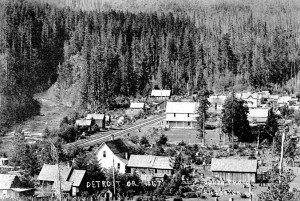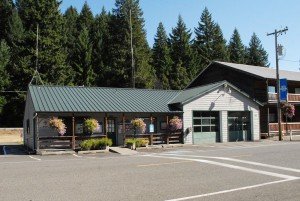 |
| Detroit in 1912 ~ now under the waters of Detroit Lake |
Tom had driven about 50 miles east on Highway 22 when Detroit appeared like a bright roadside attraction inviting us to stop and look around. Although the city had a beginning similar to the other towns you pass along the North Santiam River, this one has had a very different history. And, as we found, has a unique personality today.
In 1889 it was a work camp for the Oregon Pacific Railroad, cutting its railway though the Cascade forests. The 1890 bankruptcy of the company halted construction of the line four miles east of the town. Still, Detroit survived with logging the dense conifers. And sportsmen had easier access for their outdoor recreation.
On February 22, 1893, John Hollingsworth arrived in the settlement then called Coe. He later stated “there was no town…It was solid lumber from Niagara clear up beyond Detroit… The only opening was for the railroad with every so often a clearing for cedar posts and railway wood. Above, in the lakes, thousands of fish… would swim in schools near the shore.” When a post office was considered in 1891, the US Postal Service refused the name Coe, as it resembled Cove too closely. The homesteaders, most of whom were from Michigan, chose the name Detroit. Population increased and a school district opened the next year, 1894.
In 1894, Montana timber baron A.B. Hammond bought the bankrupt Oregon Pacific Railroad, changing its name to the Oregon Central and Eastern Railroad. He established lumber camps in the area, shipping logs to nearby Mill City. By 1926, the first modern road was completed and the Hamman Stage Line provided bus service to and from the Valley. The railroad also brought sportsmen to the area, seeking fish and game in the Cascade Mountains. Other visitors passed through on their way to Breitenbush Hot Springs Resort, which Merle Bruckman opened ten miles east of town.
Two published mentions of Detroit include the following:
In the Salem Capitol Journal of 1900, according to Ben Maxwell, H. Jacobs advertised himself as proprietor of Hotel Santiam at Detroit where a good pack train and saddle horse were available for Hot Springs, Marion and Pamelia Lakes.
In the same newspaper of 1901, an article entitled “Looters of the Public Domain” recalls that Charles and William Thomas (formerly involved in legal charges in Gates), but now with a post office address in Detroit, swore before C. C. Loomis, Special Agent of the Government Land Office, as to the truth of a woman’s claim to having lived on and improved property in the Detroit area. The agent noted on the side of the record, “[They] do not sit well with neighbors.” The Thomas brothers, with J. A. W. Heinecke, a resident of Detroit and L. Jacobs, a Detroit storekeeper, arranged for Loomis to be provided with ample liquor and to be shown cabins purporting to be those of people making claims, none of whom had been near Detroit, and few of whom were using their own names. Jacobs swore he “knew the ‘settlers’ well” and that they traded at his store. Heinecke and the Thomas brothers took Loomis “along some well-defined trails past other settlers in that part of the country” (none near the claims to be examined) “and circled and viewed the same cabin from the rear. Running out of cabins, [Heinecke] showed one cabin three times, front, rear and side.” The June 25, 1901 proceedings of the Government Land Office describe Heinecke and Jacobs as “reliable men” and mention Jacobs operated the hotel and store “where they had to go for supplies.” The record mentions that the Thomas brothers were paid $10 for their false affidavit.
Hammond’s death in 1934 and the Great Depression brought stagnation to Detroit. The CCC ~ Civilian Conservation Corps ~ brought in some activity to the 25 businesses and 65 homes. In 1946 the Army Corps of Engineers began buying land for Detroit Dam, six miles downstream. The reservoir would inundate Detroit, but residents established a new town, tractors towing 25 businesses and 645 homes up out of the valley on skids. The new Detroit was incorporated in 1952, on a former Hammond Lumber Camp #17, next to the reservoir and Highway 22. The dam and the resulting reservoir, Detroit Lake, transformed the local economy. Salem’s Douglas McKay, then US Secretary of the Interior, dedicated the $170 million Detroit Dam on June 10 when the first of two 50,000-watt generators started operation.
 |
| City Hall in Detroit |
Today the attractive city of Detroit sits alongside Detroit Lake, one mile north of the town’s original location on the North Santiam River. It has a size of .9 square miles and a population of 205. However, the population has shifted to primarily part-time residents. Christine Pavoni, City Recorder, reports approximately 389 water accounts, meaning the city serves that many properties. Multiplied by an average of 2.5 people per household, the population swells to 972.5 or more.
In 2010, by a vote of 47-37, the citizens voted down a measure to change the name of the city to Detroit Lake. Doug DeGeorge, a local builder and motel owner who wanted to establish a new identity for the city, had made the proposal.
The Detroit restaurants and stores serve boaters, campers, and other tourists staying in town or at nearby Mongold and Detroit Lake State Park. The decline of the area’s timber industry in the 1990s led to increasing dependency on tourism. A drought in 2001 left the reservoir dry and kept tourists away, demonstrating the vulnerability of the town’s economy, as well as the resilience of its residents. With its many outdoor recreation opportunities, the City of Detroit has evolved from a logging town to a popular tourist destination. Detroit Lake is now the number one recreational lake in the State of Oregon.
 |
| Photo used courtesy Cedars Restaurant |
The day we visited Detroit for the first time, we had an appointment to meet someone in Detroit at the 65-year-old Cedars Restaurant. While waiting, we discovered the many local historical photographs mounted in the hall leading to the lounge. A waitress who noticed our interest remarked that a recent customer was surprised to identify himself as a logger in one of the pictures, taken thirty-five years ago. This may be as close to a museum as the young city of Detroit has today. This is a town that has used new circumstances to adjust its economy for local prosperity.
Most visitors arrive in the warmer months. From Mid-March through October, Detroit State Park Recreation Area (about 2 miles west of the city on Highway 22) offers nearly 300 campsites along the forested shore of the 9-mile lake. Swimming, a playground and wildlife viewing are attractions. There is a visitor center with historical exhibits and a store for supplies and gifts. In the same months, Detroit offers these events:
Two additional sources of information about the Detroit are the North Santiam Chamber of Commerce visitors guide (which can be picked up at the Detroit City Hall) and the Canyon Weekly, available by subscription through the online edition.
Although a summer recreation area, we think it might be fun to drive the 50 miles east of Salem to enjoy a snowy winter vacation in an Alpine environment just an hour away from home. Tumble Ridge Trail, accessible from Highway 22 at 1,596 feet offers three options of increasing challenge for hikers or snowshoers.
Each Tuesday, after a city was featured in that Sunday’s Statesman Journal, KMUZ broadcasted “Marion County 20”. To learn more about Detroit, listen to the podcast listed on the KMUZ archives.
